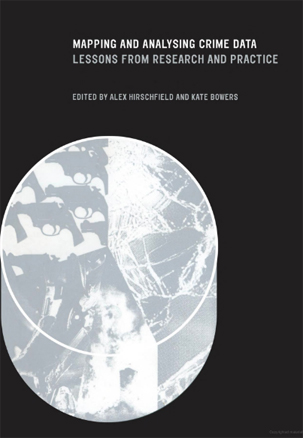Author: Edited by Alex Hirschfield and Kate Bowers
ISBN No: 9780367397371
Review date: 19/04/2024
No of pages: 274
Publisher: CRC Press
Publisher URL:
https://www.crcpress.com/Mapping-and-Analysing-Crime-Data-Lessons-from-Research-and-Practice/Hirschfield-Bowers/p/book/9780367397371
Year of publication: 03/04/2020
Brief:
This book is unusual, bordering on the odd, and that is no slight on any of the authors or the editors of this collection of chapters on crime mapping. It can take years for any publication to come to print, whether by a single academic or other author, let alone a collection or symposium after a conference. Yet this book first dates from 2001 and is out in paperback only in 2019.
It does have rather the flavour of a time capsule; before mobile phones were everywhere and the associated volume of data. What dates the work even more is that because of that time-lapse, the authors are writing about the later 1990s, in the main, which in the UK meant the Crime and Disorder Act 1998 (as referenced on the very first line of the book) and new initiatives arising from the then new Labour government.
At least this book, that could easily appear a museum piece, given the changes in tech and society, stands up really well. Partly, that is due to the quality of the contributors and their applied criminology; good, accurate and interesting work keeps well. Partly, ‘spatial crime analysis’ remains fascinating – using digital data to display crime data, and seek patterns, whether to investigate crimes, inform the community what crimes are happening in their district, even street; identify geographical ‘hot spot’ areas; and to see ‘what works’, and not only ‘interventions’ by the police, but (as in one chapter by a geographer, Steven Merrall) in fire prevention. Crime mapping involves GIS (geographical information systems) software; hence the contributors, from the UK and the United States, are geographers besides criminologists.
Right away the book is alive to the possible drawbacks, as with any computer data – GIGO (garbage in, garbage out) in a word. You can accurately geo-code a burglary in a building; what of a crime against a business’s supply chain, or on an Underground train system rather than at a train terminus? One of the doyens of crime prevention in Britain and indeed in the English-speaking world, Prof Ken Pease, made the point that a map alone will not solve or reduce crime, just as you cannot learn much from the mapping of player movements on a football field without knowing about the game’s tactics and rules; what’s normal and what’s not.
To pick out two chapters about Britain; crime mapping looked at the ‘journey to crime’ of prolific offenders in South Yorkshire; and partnership working in north London – as required under that 1998 Act, for instance by local government public space CCTV control rooms and police. Crime ‘hotspot outputs’ not only could inform where and when police should patrol, but where a council or borough should site its cameras. That remains relevant – it would be strange if it did not, given that installing a camera costs money, and in the 2010s the Surveillance Camera Commissioner in England and Wales has asked that camera sitings in public be justified.
This crime mapping field, and the contributors, have gone on to develop such work. Spencer Chainey, for instance, author of that London CCTV-based chapter, has gone on to the UCL (University College London) Jill Dando Institute of Security and Crime Science.
One advantage then as now as Chainey identified is that such data and inferences from it can be a help to get central government funding for crime prevention projects. Without data, how can you know what you are doing, or ought to do, in any work?
Other drawbacks are, to stay with London, that the city’s boroughs have been each developing their own paths in community safety and crime reduction, and overlaid on top of that is the Mayor of London’s MOPAC (office of policing). It’s all very well to have excellent data-sets – although the police are forever seemingly working to improve theirs – but even if excellent data is attained, what of the resources to make good use of it? In fairness the authors were not blind to the potential problems – arising from the ‘human factor’, in a phrase, whether managers and politicians expect too much of whizzy tech, or the operators aren’t trained right to use the products.
As the final chapter by Alex Hirschfield ends by noting, the academic may be ‘interested in explaining why crime occurs’; the police want action and results.
Some things have changed greatly since 2001; such as computing power and the sheer amount of data; and entire new fields of study have arisen, such as data visualisation. Other things are still around, such as drug markets, although the criminals may be highly fluid, for instance moving to ‘county lines’, another example of the value of good crime mapping.
Hirschfield sums up: “The way forward must be one of dialogue and exchanges of views, of experiences, of ideas and learning as well as the pooling of data.” While that reads well today, and crime data can usefully have health and other data added (fraud against online retail?), just that phrase ‘pooling of data’ requires bureaucracies to know of, and trust one another. That may be as elusive in 2020 as 2001.










